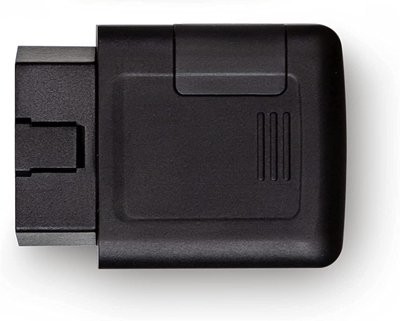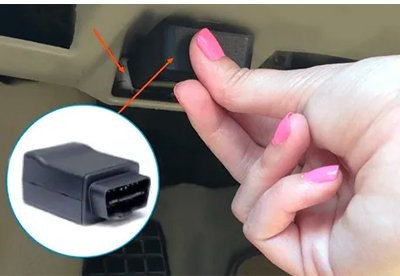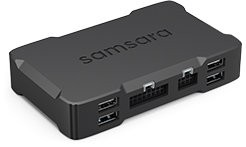Ever heard this story? Tony, owner of 123 Plumbing, aimed to cut costs by tracking his small fleet of vans. A quick online search led him to a cheap GPS tracker, promising easy OBD-II port plug-in and instant data, seemingly without monthly fees. But within a week, his vehicles faced electrical problems, one with a dead battery.
What went wrong? Tony’s budget OBD-II trackers clashed with the vehicles’ onboard computers, causing a costly mess. This is a risk for anyone, particularly with newer plug-and-play devices.
Small business owners lack the time and money to learn the hard way about OBD-II tracker issues. That’s why we’ve created this detailed guide to OBD-II vehicle trackers. We’ll cover:
- What OBD-II trackers are and how they function
- Leading plug-and-play GPS trackers available today
- Which OBD-II GPS tracker is the best choice for small businesses
What is an OBD-II Tracker?
OBD-II GPS trackers are GPS tracking devices that install directly into a vehicle’s onboard diagnostics port. Unlike hardwired GPS trackers that need professional installation into a vehicle’s battery and ignition, these plug-and-play devices simply connect to the OBD-II port.
The Benefits of OBD-II Trackers
OBD-II GPS tracking devices offer numerous advantages, especially for small businesses. They are simple to install and work with almost every car, truck, or van made since 1996. Avoiding professional installation saves money. Top OBD-II trackers are also discreet, easily hidden, and avoid messy cables.
Beyond simplicity and looks, OBD-II trackers record and send useful vehicle diagnostic data that usually requires a mechanic. When your vehicle’s “check engine” light comes on, the best OBD-II GPS trackers provide the diagnostic trouble code, or DTC code, in plain English. Access to onboard diagnostics means good OBD-II trackers offer a wide range of features including vehicle health and maintenance monitoring, driver safety features, idling and fuel consumption reports, and more. They also maintain data flow even when the vehicle is off.
Due to their easy installation and small size, OBD-II trackers are perfect for trucks, vans, and other light to medium-duty vehicles.
How to Install an OBD-II Tracker
Installing an OBD-II tracker is straightforward. Locate the OBD-II port, typically under the steering wheel on the driver’s side, and plug in the device. Then, drive the vehicle briefly to calibrate it.
The Best OBD-II Trackers
As with most tech solutions, OBD-II trackers vary, and not all suit every business. We’ve reviewed the most popular OBD-II trackers to help you find the service that best fits your needs.
Force Fleet Tracking
| Pros | Cons |
|---|---|
| No contracts | No hard-wired option |
| No hidden fees | Not available for personal use |
| Hardware included in price | Free hardware must be returned upon cancellation |
| Vehicle health & maintenance alerts included | |
| Idling reports | |
| Driver safety tools | |
| RoadScore for driver behavior | |
| TireCheck for tire monitoring | |
| Route histories | |
| Alerts for harsh braking, speeding, dangerous driving | |
| Disturbance alerts |



Force Fleet Tracking is designed for small businesses, using OBD-II GPS tracking to offer actionable fleet insights. It’s user-friendly, affordable, and delivers a full suite of powerful features for a single price – no extra costs.
Force’s plug-and-play OBD-II tracker, about the size of an Airpods case, installs discreetly and requires no contracts.
This GPS tracking solution addresses key operational challenges for small fleets, monitoring vehicle health, improving driver safety, and tracking vehicles in real-time.
The Force platform also sends real-time alerts for risky or unauthorized actions, like drivers leaving geofenced areas, unplugging trackers, or unsafe driving. It keeps detailed trip histories with times, mileage, speed, routes, and driving behavior. Idling and maintenance reports can save Force customers up to 40% on fuel.
Force’s OBD-II GPS Trackers also provide real mileage-based maintenance tracking, reports, and alerts. Force notifies you when vehicles need maintenance. These maintenance features are standard, unlike Momentum IoT and Verizon Connect, which charge extra. Learn more here.
See real-time savings. Explore Force’s fleet pricing.
Vyncs GPS Tracker
| Pros | Cons |
|---|---|
| Roadside assistance add-on | Annual contracts require long-term commitment |
| Unsafe driving alerts | Activation fees |
| Geofences | Hidden costs for essential features |
| Location tracking | Slow standard refresh rate |
| Companion app for mileage tracking | |
| Maintenance reminders |
Vyncs often appears in searches for GPS trackers without monthly fees, but this is misleading. Vyncs uses annual plans with basic, premium, and professional tiers, adding features like roadside assistance.
Vyncs charges extra for features often standard with fleet tracking services. For instance, 20-second GPS updates cost an extra $40 per device annually, Live Map Auto Refresh is $30 more per device per year, and ‘driver safety supercharge’ adds $35 per device annually. There’s also a $39.99 activation fee per device, on top of annual pricing.
While Vyncs offers faster updates at a premium, the standard refresh rate is a slow 3 minutes.
On the plus side, their app tracks mileage, distinguishes between work and personal driving, and maintenance alerts flag minor issues, battery levels, and recalls.
Connect OBD-II GPS Tracker
| Pros | Cons |
|---|---|
| Vehicle maintenance alerts | Annual billing |
| Safety alerts for aggressive driving and hard braking | Very expensive hardware |
| Historical driving activity | |
| 3-second refresh rates | |
| Aggressive driving, hard braking, and low fuel alerts | |
| Speeding and battery alerts | |
| Geofencing |
The Connect OBD-II GPS tracker from Tracking System Direct provides basic GPS tracking with standard features at a premium price. With hardware near $400, more is expected. While it has 3-second GPS refresh rates, fleet telematics rarely needs updates faster than 10 seconds.
Like Vyncs, Connect advertises no monthly fees but bills annually and charges above-average hardware costs.
OneStep GPS
| Pros | Cons |
|---|---|
| 2-60 second updates | Activation fee |
| Safety alerts | Requires first and last month payment upfront |
| Geofencing | |
| Speeding, harsh braking, idling alerts | |
| Vehicle service reminders | |
| Fuel usage monitoring |
OneStep GPS offers vehicle tracking for personal and fleet use. It alerts you to poor driving habits like speeding, rapid acceleration, hard braking, idling, and after-hours driving. Basic reporting is available through their web app, but it’s less comprehensive for business use as it was initially for personal tracking.
Unlike business-focused solutions, OneStep GPS requires payment for the first and last month plus a $20 activation fee, a significant initial cost.
Azuga
| Pros | Cons |
|---|---|
| Intuitive app | 36-month contracts |
| Driver safety features | No free trials |
| Vehicle maintenance reports | Slower refresh rates compared to competitors |
| Dispatch capabilities | More expensive for similar features |
| Idling monitoring | |
| Geofences | |
| Timecards | |
| Advanced smart routing system add-on |
Azuga is a fleet tracking solution for monitoring driver behavior, setting geofences, and providing in-cab safety alerts and driver coaching. Azuga excels with Azuga Routes, an add-on for route scheduling with telematics data, considering commercial restrictions, time windows, weight limits, weather, and more.
They offer tiered pricing with 3-year contracts. Their basic plan at $25 per vehicle monthly lacks standard fleet tracking features like vehicle diagnostics, maintenance alerts, or trip logs, unlike many competitors. Minute-by-minute tracking requires a $35 monthly subscription, which is costly, and competitors offer faster refresh rates on standard plans.
Momentum IoT
| Pros | Cons |
|---|---|
| No contracts | Fleet maintenance and equipment tracking extra cost |
| PowerSense add-on for equipment tracking | Lacks dedicated driver safety features |
| Asset tracking for job sites | Limited diagnostic descriptions and DTC codes |
| Geofences | Bulky hardware with exposed cables, potentially intrusive under dash |
| Speed alerts | |
| Mileage history |
Momentum IoT is a GPS fleet tracking solution for small to mid-size fleets of trucks, trailers, heavy equipment, and light equipment.
Momentum IoT offers a simple solution for construction, oil & gas, and agriculture to track fleets and get basic reports. Preventative maintenance and vehicle service alerts are extra.
Momentum IoT includes geofencing, speed alerts, and trip/mileage history, but lacks harsh braking or unsafe behavior alerts, and maintenance features are not standard. More detailed insights like preventative maintenance and tool usage require additional fees.
Alt text: Momentum IoT OBD-II tracker, a GPS fleet tracking device for trucks and heavy equipment, highlighting its robust design for industrial applications.
Discover why small businesses prefer Force. Read customer testimonials.
Verizon Connect
| Pros | Cons |
|---|---|
| International coverage | Long contract terms |
| Automated maintenance alerts | Expensive compared to similar services |
| Unauthorized break or detour tracking | Steep learning curve for full feature set |
| Dynamic routing | |
| Live map with route replay | |
| Speed alerts | |
| Geofences |
Verizon Connect is a GPS fleet tracking software with many add-ons and extensive data collection. Beyond standard fleet tracking, it offers in-depth analytics, asset tracking, and route optimization add-ons with apps for drivers and managers.
Larger fleets with data analysts may benefit more from Verizon’s services due to the volume of data for insights.
Samsara
| Pros | Cons |
|---|---|
| Automated maintenance alerts | 3-5 year contracts |
| Vehicle diagnostics dashboard | Hardware purchase required |
| Heat maps of routes | Minimum vehicle commitment and contract length unsuitable for small businesses |
| Real-time vehicle location | |
| Dash camera add-ons | |
| Temperature probes for sensitive cargo |
Samsara is a comprehensive platform for large fleets, providing tracking, fuel and maintenance data, and equipment monitoring for trailers, large trucks, facilities, and construction sites. Samsara offers various hardware add-ons including trackers, dash cams, environmental monitors, temperature probes, and asset trackers for industrial uses.
Samsara offers strong enterprise solutions, but its long contracts and complex setup are not ideal for small businesses.
The Final Word on GPS Trackers for Small Business
Compared to other fleet management tools and plug-in trackers, Force is the Best Obd2 Vehicle Tracker option for small businesses, largely due to the GPS tracker hardware itself.
Force’s hardware is superior to other GPS trackers. It’s easy to install, minimizes power draw and vehicle electronic interference, helping preserve battery life.
Many services fail to ensure their OBD-II port trackers don’t interfere with the vehicle’s Electronic Control Unit. Devices differ, and GPS trackers aren’t all made equal. With Mojio’s decade in this field, Force has the most extensive vehicle data library in the industry.
Combining a vast vehicle diagnostics library with 10-second GPS updates and features for small to mid-sized field service businesses, Force offers the best GPS trackers for small businesses without risking electronic issues.
Experience the Force difference, risk-free. Start your free trial today.
Frequently Asked Questions
How is Force different from other fleet tracking software?
Force is specifically designed for small businesses and home service companies. With user-friendly features, affordable pricing, and no contracts, Force offers the best value for fleets of 2+ vehicles.
How does the free trial work?
Signing up for a 14-day free trial gets you free GPS trackers for each vehicle. Continue using Force after the trial, and billing starts 14 days after your trial begins. To cancel, notify the team for a prepaid return label for the devices.
How do I know if my vehicle is compatible?
Force works with almost any vehicle having an OBD-II port, including most cars, vans, and light trucks from 1996 onward. Contact the team to verify your vehicle compatibility if unsure.
How long does installation take?
Force installs in minutes per vehicle. Plug the devices into the OBD-II port and follow simple on-screen instructions in your browser.
What if I need help getting started?
Force is designed for easy setup and use. Force’s support team and Help Center are available to assist you.
How much money can my small business save using Force Fleet Tracking?
Savings from GPS fleet tracking depend on your business challenges. Preventing wage loss, curbing poor driving habits, avoiding breakdowns, and improving customer satisfaction quickly add up. A 5-vehicle fleet can save over $4,400 yearly in fuel by managing idle time alone, not including gains from on-time job completion.
Try the solution built for you. Start a free trial of Force Fleet Tracking today, no commitment required.
START FREE TRIAL
Published May 1, 2023